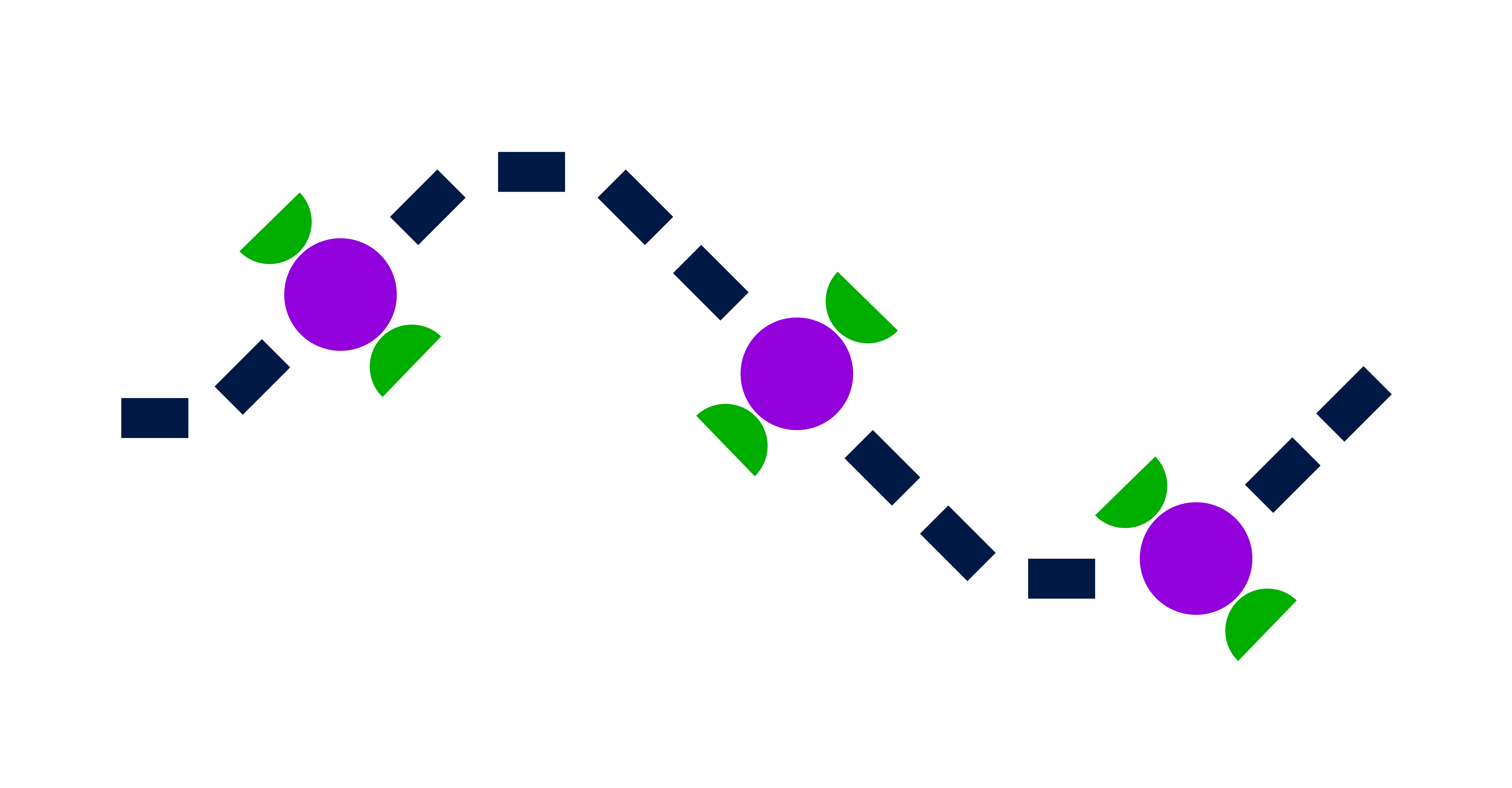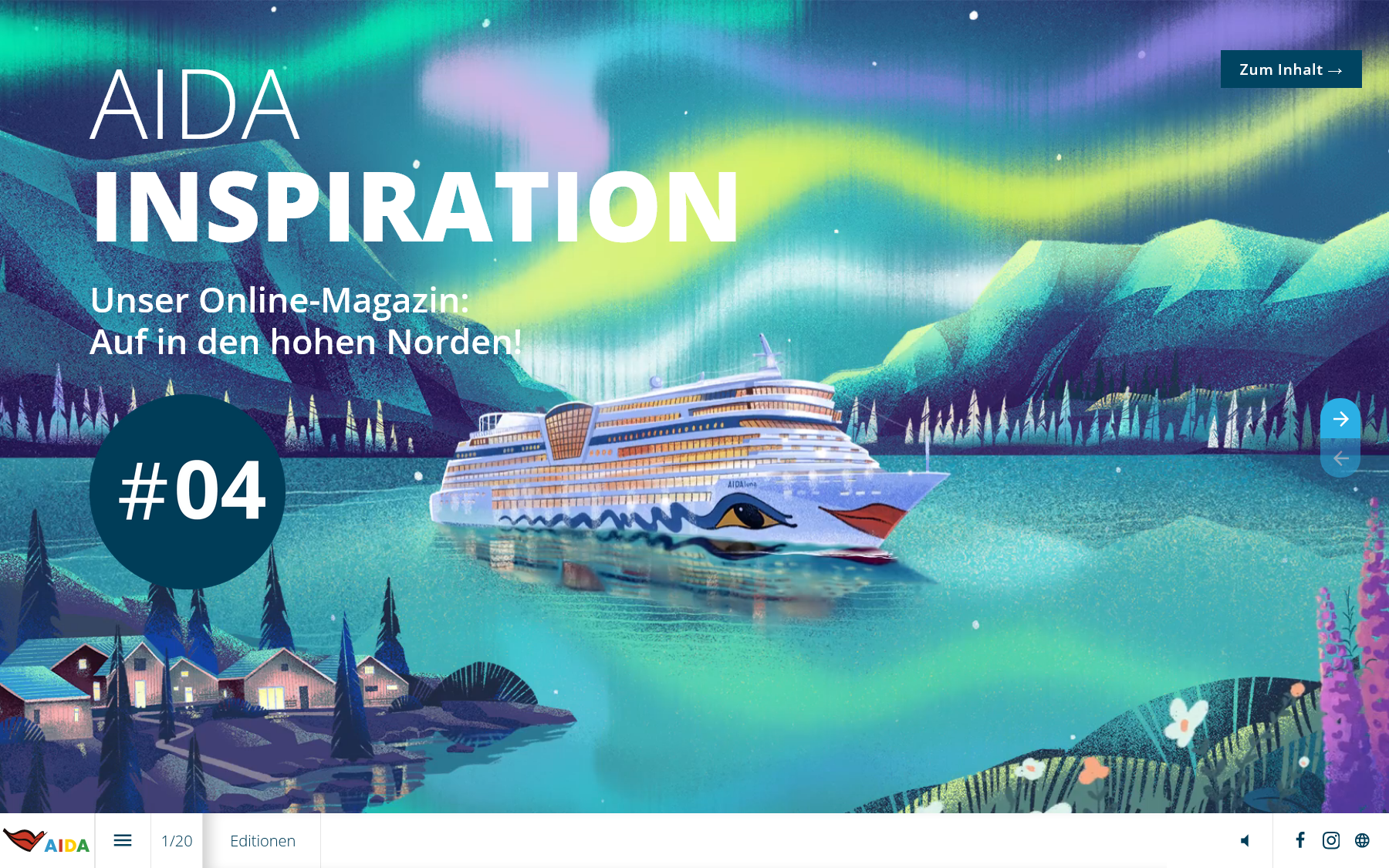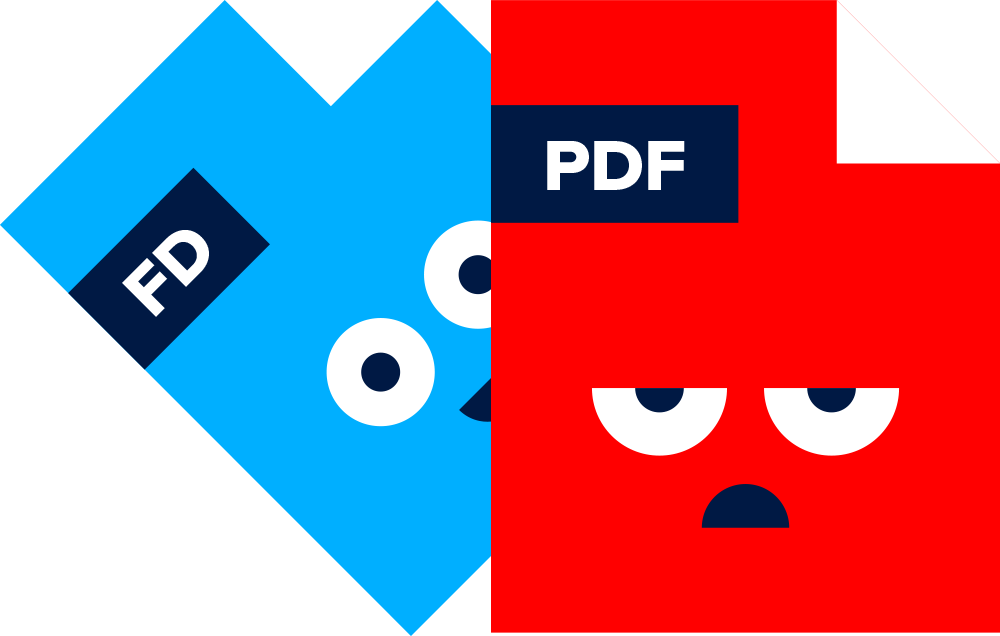Introduction
So you're thinking of creating a digital magazine. You probably have many questions about digital publishing. We'll cover where to start with your digital magazine, what design software to use, how to distribute it, and more.
Maybe you have a print magazine and are weighing the benefits of creating an online magazine. You want to reach more people, save on production costs, and add interactive features to your readers. Whatever your situation, this guide will help you achieve those goals.
After reading this, you'll be prepared to take the next step in content marketing toward becoming a digital publisher and creating digital magazines online
1. Digital magazines vs. online magazines
Firstly, in content marketing, plenty of terms fly around (digital magazine, online magazine, ezine, webzine, digital edition, digital publication, magazine apps, etc.). It can be difficult at first to get past all the lingo, so let’s start by clearing it up.
1.1 What is a digital magazine?
Simply put, a digital magazine has many of the same characteristics as a print magazine but uses digital publishing technology so it can be used in an online format.
There are plenty of advantages to using a digital magazine. You can cave a lot on printing costs. Online options are also better for the environment. Plus, they help you each more people. Depending on the technology used, digital magazines can also have aesthetic and functional benefits. For example, they may contain animations, hyperlinks, videos, and other dynamic content.
You might be surprised to learn that the first digital magazines were produced in the 1980s! Diskzines (or diskmags) were magazines distributed on floppy disks via post and read on a computer. PCLife was one of the first to create digital magazines in this format. The digital magazine was an executable program that included music, animation, and various forms of multimedia.
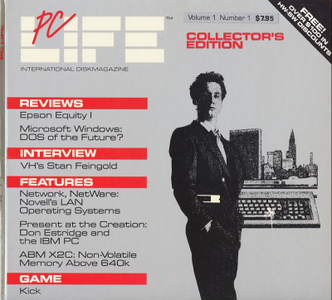
By the mid-1990s, floppy discs were mostly replaced by CD-ROMs that could hold far more data. And by the 2000s, most print magazines moved online.
1.2 What is an online magazine?
Online magazines (or ezines, e-zines, eMagazines, webzines) are digital magazines that are hosted, distributed, and read online. While they share some characteristics with online newspapers and blogs, the editorial approach for digital magazines remains more like traditional print magazines.
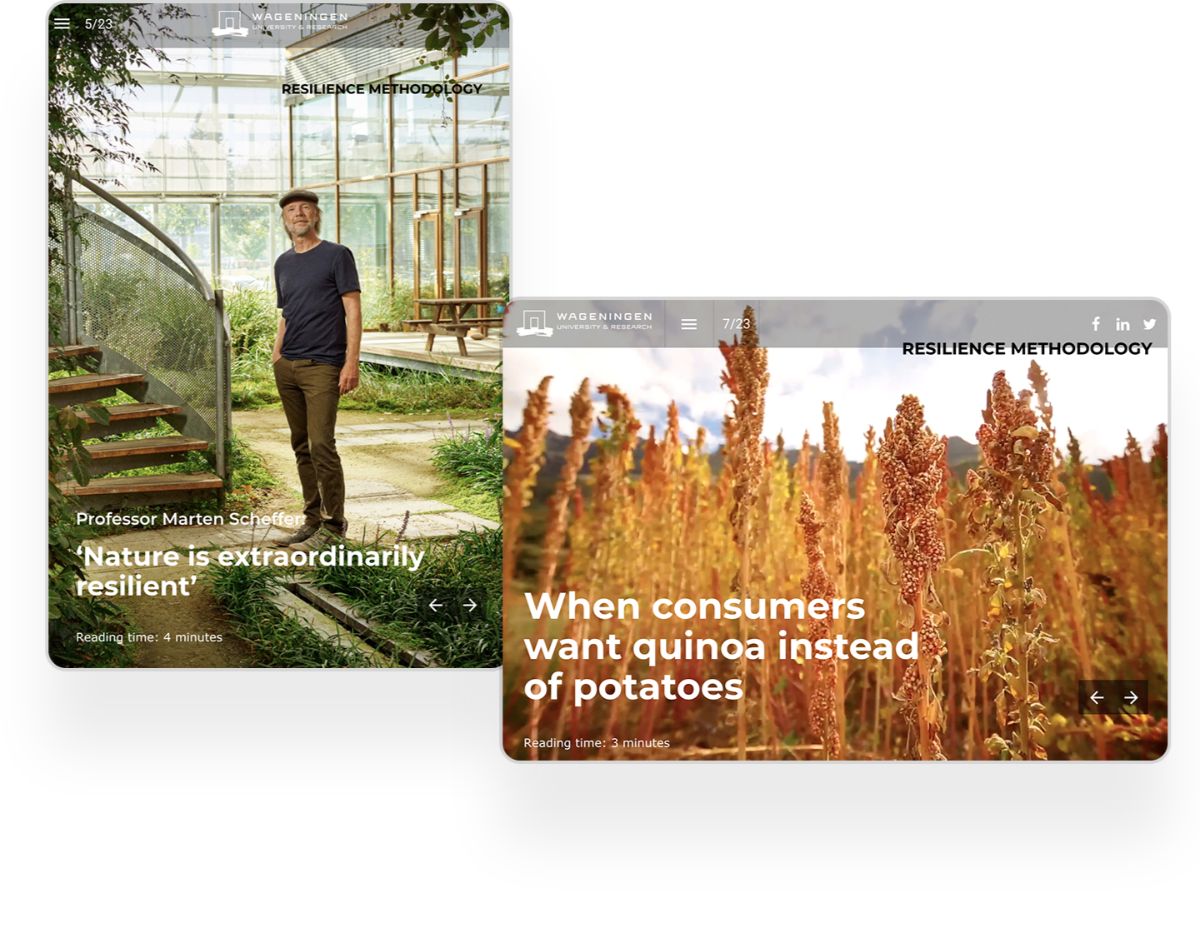
Online magazine example from Wageningen University
Because of their low cost compared to print, online magazines can be seen as a disruptive technology. Many digital publishers have created online editions of their magazines (referred to as digital editions), or switched exclusively to digital magazine formats.
The relative ease of producing digital online magazines allows virtually anyone to create, publish, and distribute their online magazines and achieve a wide readership.
TL;DR
- Digital magazines: Any magazine that can be read on an electronic device.
- Online magazines: Digital magazines that are hosted, distributed, and read online.
- Digital edition: An online version of an existing print magazine.
For the remainder of this article, we'll be using the terms "online magazine" and "digital magazine" interchangeably, as virtually all digital magazines are now online.
2. Types of digital magazines
Today, online magazines can be found in many different formats. They can be standalone publications on the web like this one from Nestle, they can be native apps for iOS or Android like this one from the Economist, or they can be part of a magazine subscription service like Zinio or Kindle Newsstand. Additionally, many online magazines offer newsletters to keep readers updated on the latest content and news.
Below, we’ll talk about different types of digital magazines and rate them based on the effort each takes to create and the impact they’re likely to make.
2.1 Flash magazines
Flash was a technology initially created by Macromedia and later bought by Adobe. In the early 2000s, many online magazines used this popular format. It allowed for rich multimedia and simulated page turning, like a printed magazine.
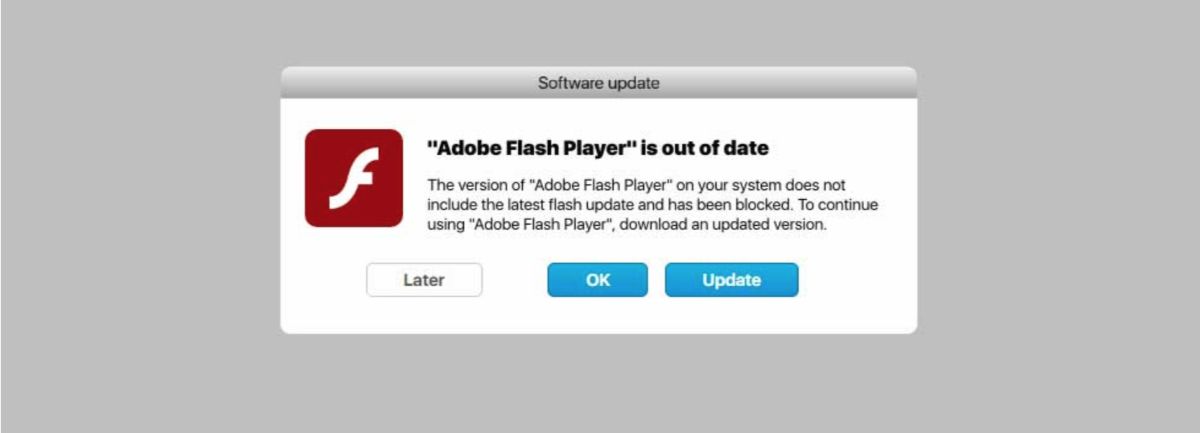
However, Flash as a technology has declined significantly, and many major devices (like the iPad) no longer support it. If you plan to create an online magazine, you’ll probably want to avoid Flash because of the minimal support.
Effort: High
Impact: Low
2.2 PDF magazines
Other online magazines use PDFs. This is an easy and cheap solution, especially if you already have a printed magazine. With PDF, you can make an exact copy of your printed edition. Most design software can easily export to PDF.
However, there are some big drawbacks to using PDF for digital magazines.
PDFs are fixed-layout documents made for printing. This means that magazines which may look okay on a desktop, will be:
- Difficult to read on a mobile device
- Usually require zooming in and panning around
In the mobile-first age, most people don’t want the hassle of looking at something that doesn’t fit their screens.
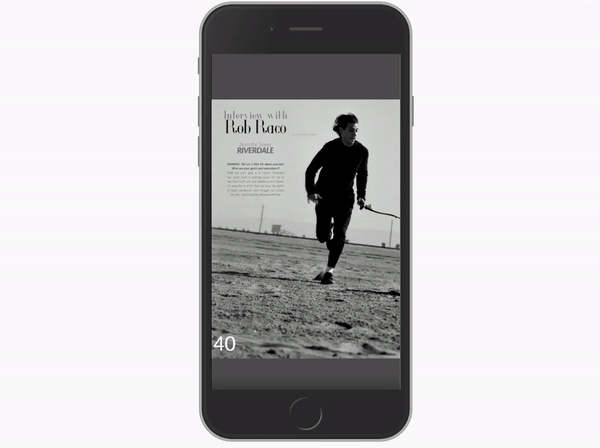
Reading a PDF magazine on a mobile phone
Furthermore, digital magazines in a PDF format require readers to download them before viewing them. This is already a barrier for desktop users, but for mobile users, downloading files — and then finding them in your phone’s local storage — remains an almost alien task.
Check out these 9 reasons why you should avoid using PDFs.
Check it out
Finally, generating leads, subscribers or revenue with PDF-based digital magazines is hard. This is because you cannot control how they are shared or measure their impact.
Once downloaded, readers can share them with their network. You cannot track how readers use them making measuring the ROI of your content marketing near impossible.
Related: How to track your white papers properly.
Effort: Low
Impact: Low
2.3 Flipbook magazines
As online magazines evolved, a new take on PDFs emerged called flippable (or browsable). These PDF digital magazines are usually found on websites. They can mimic the flipping of pages, just like a printed magazine. Essentially, they act as a digital replica.
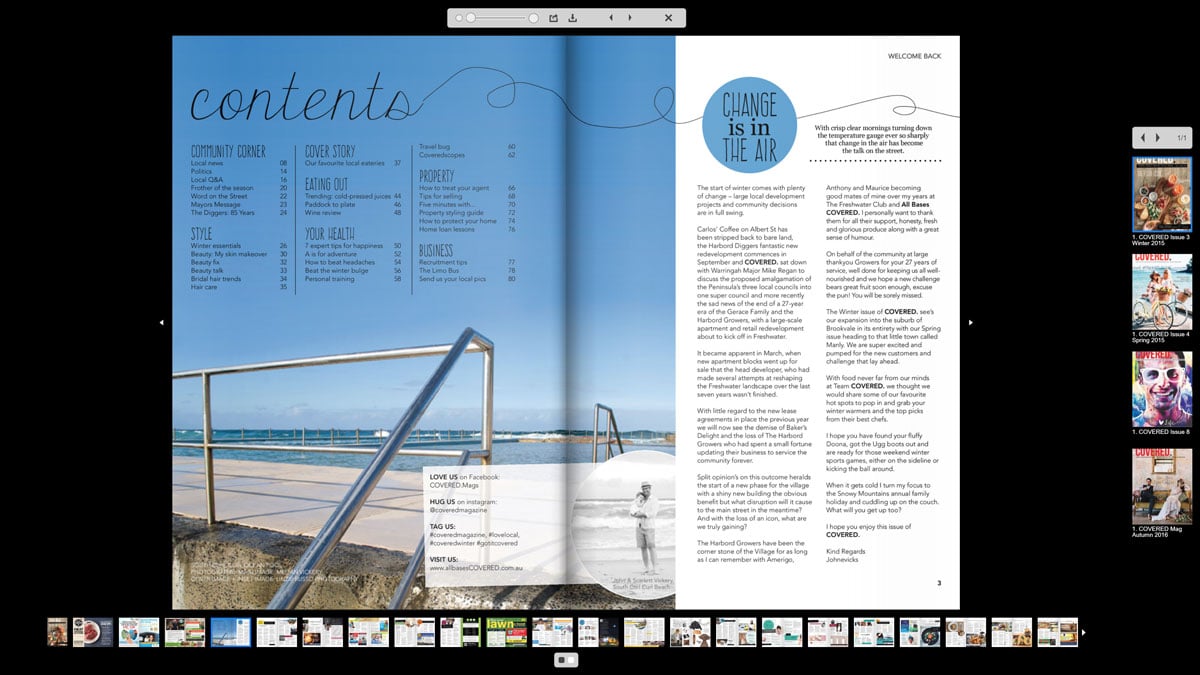
Here is an example of a flipbook magazine.
The same advantages apply to flipbooks as to simple PDF magazines. It is very easy to take a printed magazine and turn it into a digital format. As an additional benefit, readers can access the online magazine without downloading it first.
However, the same disadvantages apply as well. Try opening the above example on a mobile phone. Because of the fixed layout, flipbooks are extremely difficult to read on mobile without zooming in and out.
Effort: Medium
Impact: Low
Find out more about the alternatives to PDF flipbooks.
Learn more
2.4 Native app magazines
Some publishers decide to create their own native app for their magazines. A native app simply refers to an app you can buy in the Apple or Google Play store for your iOS or Android device. These cannot be used on a traditional desktop or laptop computer.
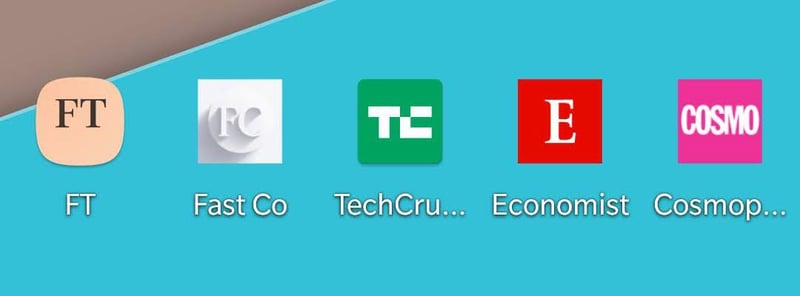
Some native app magazines
Native app-based digital magazines likely provide the best reading experience on mobile devices. Developers have almost full control over the design and feel of the online magazine.
They can use digital text reflow. This means the text size and layout change based on the screen size. It provides a better reading experience on any device.
In addition, native apps can contain all kinds of extra functionality. They can pull in dynamic, personalized ads. They can download editions for offline reading. They can include rich multimedia.
They can also track and measure reader behavior so that the publisher knows what types of content are popular among various segments. And the list goes on.
However, native apps have their downside as well. Most obviously, they are very time-consuming and expensive to develop. In addition, you are dependent on Apple or Google to approve your app (which can take time), and they will take a cut of any revenue you earn.
Also, apps need to be downloaded, which is an extra step for your readers. This is important because people are more careful about what they install on their phones.
If you can’t afford to hire your developers, numerous services offer to create simple digital magazine apps for you. However, most of these simply convert PDF files, and you end up with many of the same display issues as with flipbooks.
Effort: High
Impact: High
2.5 Magazine subscription apps
Google Play Newsstand and Apple Newsstand have been discontinued and replaced with Google News and Apple News, respectively — simple news aggregators like Flipboard that pull in blog posts and articles from various sources.
However, some major players in the magazine subscription service space still exist, including Amazon’s Kindle Newsstand, Zinio, Texture, Magzter, Readly, and more.
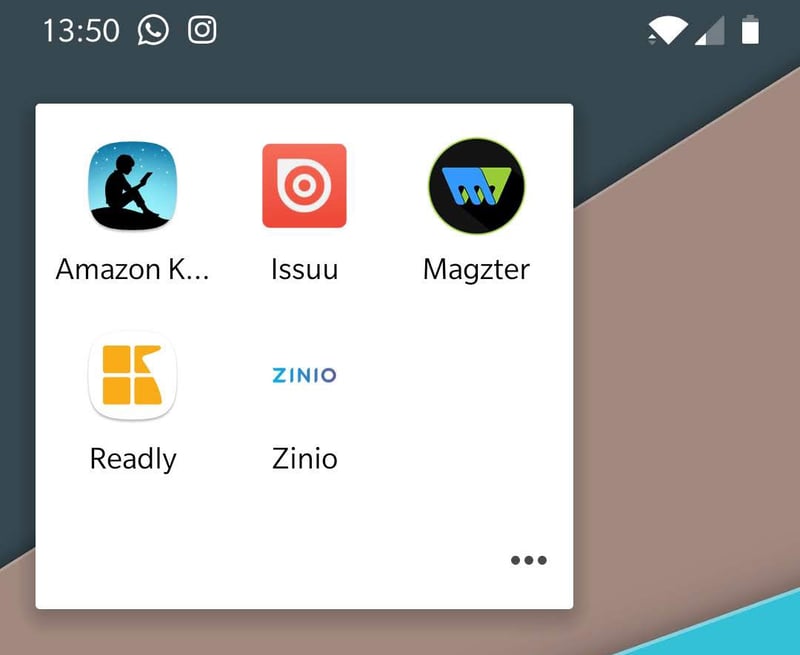
Some popular magazine subscription apps
Each of these is a native app. Users must create an account and add payment details. Then, they can subscribe to thousands of magazines made for the platform through in-app purchases.
Many publishers decide to produce online digital magazines for one or more of these platforms rather than developing their apps from scratch because these services already have a large user base.
Creating online magazines for these platforms is more limited than making your app. You have to follow the platform's guidelines, which can be confusing. While the process is easier than creating an app from scratch, you will still need developers and designers to assist you.
If you choose this option, remember that you will compete with many other publishers. They are also on these platforms trying to get their magazines noticed. Many of these platforms charge a significant membership fee to become a publisher, and also take a percentage of your sales.
Effort: High
Impact: Medium
2.6 HTML5 magazines
Last but not least are HTML5-based magazines. These are digital magazines that use the same technology websites depend on — HTML, CSS, and JavaScript. They’re designed to work in any modern web browser and are thus appropriate for desktops and mobile devices.
Unlike fixed-layout PDFs or flipbooks, HTML5 magazines use responsive design principles to adapt layout and typography according to the reader's screen size. When read on a computer, they feel much like using a modern website — except with a linear flow. When used on a mobile device, they feel like interacting with a native app.

HTML5 magazines work great on any device
The big advantage over native apps is that — because they use simple web technology — they require only a fraction of the resources to develop, and you don’t need to create more than one version for Android and iOS.
Additionally, HTML5 digital magazines can be hosted anywhere you choose, so you’re not dependent on Google, Apple, or other services for distribution. This makes it a cost-effective and flexible option for those looking to start their own online magazine using the latest tech.
Other benefits include tracking reader behavior and measuring their engagement. You can also update digital magazines after they are sent out. Additionally, you can control what search engines index. This way, your magazine's content appears in search results as you want.
There are quite a few platforms for developing HTML5 digital magazines, and they all vary in price and options. Foleon offers a powerful drag and drop editor for creating and publishing your own multimedia-rich, interactive, HTML5-based digital magazines and comes with a free trial.
Effort: Low
Impact: High
3. Choosing what type of magazine is right for you
Now that you're familiar with different types of digital magazines, you must decide which one is right for you. This largely depends on your goal, your budget, the available time, and whether you already have a printed edition.
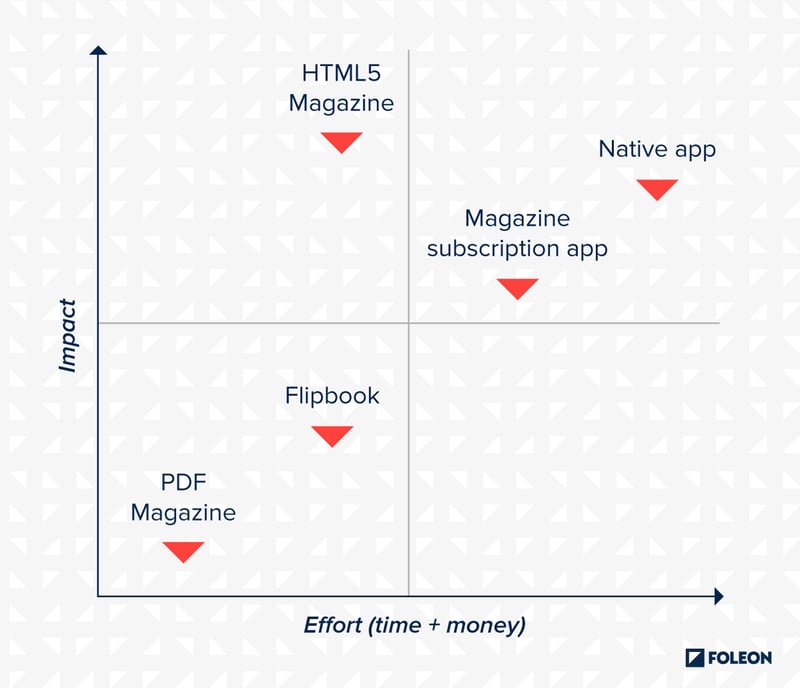
3.1 Low cost options
If budget is your biggest concern, creating a PDF is the cheapest solution. All you need is good content and a proficient graphic designer in InDesign.
If you already have a printed edition and want to go for something slightly fancier without spending much, a flipbook (or digital replica) might be best for you.
Just keep in mind the drawbacks we discussed in the previous chapter: PDFs and flipbooks don’t do well on mobile devices, so you risk alienating a large segment of your potential audience. Also, controlling distribution is difficult as your audience can freely share your magazine.
Discover: PDF Flipbooks - Should you create them?
3.2 High impact options
3.2.1 When to choose a magazine subscription app
If you have a printed edition and want to keep its style and format, consider a magazine subscription app. Apps like Kindle Newsstand or Zini can help you earn money through subscriptions.
If you choose this route, you must go through a vetting process before your magazine gets listed. You will also need to pay a membership fee, and likely hire a developer to create XML exports of your magazine.
Even then, there is no guarantee you will build an audience. You will compete with thousands of other magazines on their platforms. You can also expect to pay a percentage of the subscriptions you sell.
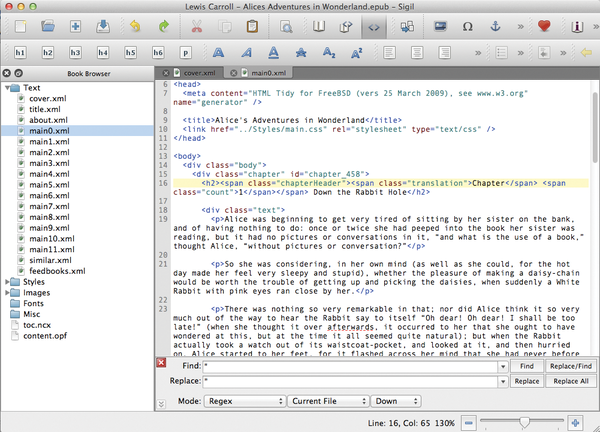
Example XML code for a digital subscription app magazine
3.2.2 When to develop a native app
If budget is not a concern, and you’re willing to invest in serious development, you might consider creating a native app. This gives you a lot of flexibility in the user experience. It also offers several ways to make money, like app sales, in-app purchases, or advertising. Just keep in mind, you will only reach mobile readers, not desktop users.
Youw will need to follow Google and Apple's quality control rules and terms. You will also have to share part of your profits. And again, the app store is crowded, so unless you already have a strong brand, there is no guarantee readers will ever find you.
You can learn more about submitting a magazine app to the Apple app store here.
3.2.3 When to choose an HTML5 magazine
If maximum impact is your goal and you can’t afford a team of developers, an HTML5 magazine is probably the way to go. They allow you to reach computer and mobile users with an equally immersive reading experience, and you won’t be subject to anyone else’s terms and conditions.
An HTML5 magazine lives on its own domain (e.g., yourmagazine.com), and users can read it with any modern browser, so you don’t have to worry about compatibility issues. And just like with native apps, you have tremendous design freedom. You can embed rich media like background videos and create fluid animations as users turn pages.
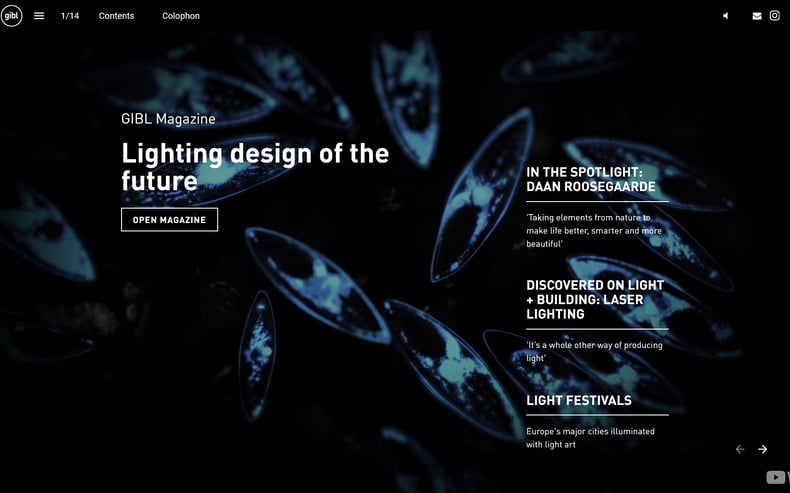
An HTML5 Architecture Magazine from Trilux
Because they use the same technology as websites, you can put anything in an HTML5 magazine that you could on a regular website, including forms, overlays, frames and embeds — even 3rd party tracking scripts and remarketing pixels.
Watch out, though; many platforms that claim to produce HTML5 magazines just create flippable PDFs that suffer from the same poor mobile experiences we discussed earlier. These can be spotted quite easily as they typically offer to "convert" your PDFs.
For a high quality HTML5 magazine platform, check out Foleon’s no-code, drag & drop, true HTML5 magazine builder.
4. What’s the goal of your digital magazine?
At the outset of any substantial project, it's important to start with the goal in mind. Creating an online magazine is no different.
Online magazines can have various goals. They may aim to make money through user subscriptions or by selling ad space. They can also support your content marketing strategy.
Knowing your target audience and the goal of your online magazine will influence your platform choice. It will also affect your layout, design options and editorial formula.
4.1 Selling subscriptions and ads
When most people think of a magazine, they think of good old-fashioned subscription-based magazines. The goal is simply to generate revenue through subscriptions and/or advertising. Of course, for this to be a feasible goal, you need high-quality content that people are willing to pay for and a good digital marketing strategy.
More and more publishers offer "freemium" models — that is, they offer some of their content for free but then require a subscription for unlimited access to all of their content. National Geographic, for example, offers plenty of free articles on their website and in their native app, but if you want the full experience or access to past editions, you must subscribe.
Many online magazines, such as The Economist and FastCo, offer their digital edition for free if you are also subscribed to their print edition. Others, like Extra Crunch from TechCrunch offer only an online edition.
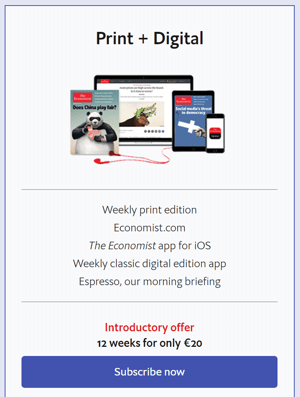
If you have a printed magazine with many subscribers, you need to consider the role of your digital edition. Will it be a standalone product that you sell separately. Will it be an online version that print subscribers get for free? Or will it be a supplement with exclusive content that offers exclusive content not found in the print edition.
If you're just starting, on the other hand, you may want to consider a free or freemium model, at least until your magazine gains enough traction to begin charging a fee. Most new magazines choose this route, relying on advertising revenue to turn a profit.
4.2 Engaging readers
Not all magazine producers are publishers per se. Companies in many industries create magazines to keep their customers informed. These magazines inspire readers with interesting content and help them stay engaged with the brand.
In this sense, digital magazines can be a powerful tool in your digital marketing strategy by increasing brand awareness and entertaining your readers with content that appeals to your target audience.
Some great examples are Red Bulletin by RedBull and Airbnb magazine. Neither of these companies are primarily publishers, but both produce great magazines to keep their target audience engaged and enthusiastic about their brands and the lifestyles associated with their products and services.
While the above-mentioned examples charge subscription fees, other companies simply produce digital magazines for free.
In this case, the goal is not to sell subscriptions or earn revenue directly — the benefits in reader engagement offset the production costs. Organizations that have other primary revenue-generating activities create magazines to use as valuable communication assets.
Whole Foods Magazine, for example, is a completely free nutritional magazine produced by the supermarket chain, Whole Foods, in both print and online versions. It contains news and editorial content, original research, and more.
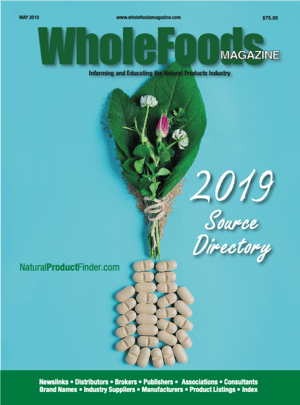
It is not a place where Whole Foods advertises its products. Rather, it contains all kinds of content to inspire people interested in nutrition and healthy eating. By engaging and inspiring their audience in this way, Whole Foods indirectly encourages more shopping.
It's worth noting that, even though Whole Foods Magazine is free for readers, they also include advertisements to help finance it.
Another example where engagement is the main goal are staff magazines. Many large companies produce magazines for internal distribution among their employees. Again, the objective here is reader engagement — to keep their workforce informed, happy, and more productive.
4.3 Selling products or services
A third goal you might have in mind is not to sell the magazine itself, but to use it to sell your products and services. In this case, your magazine would resemble something of a product catalog or brochure.
The most obvious example of this type of magazine would be the duty-free shopping magazines you find on airplanes. These are magazines full of nothing but ads, and while they may be in a magazine format, their main purpose is to get readers to buy something.
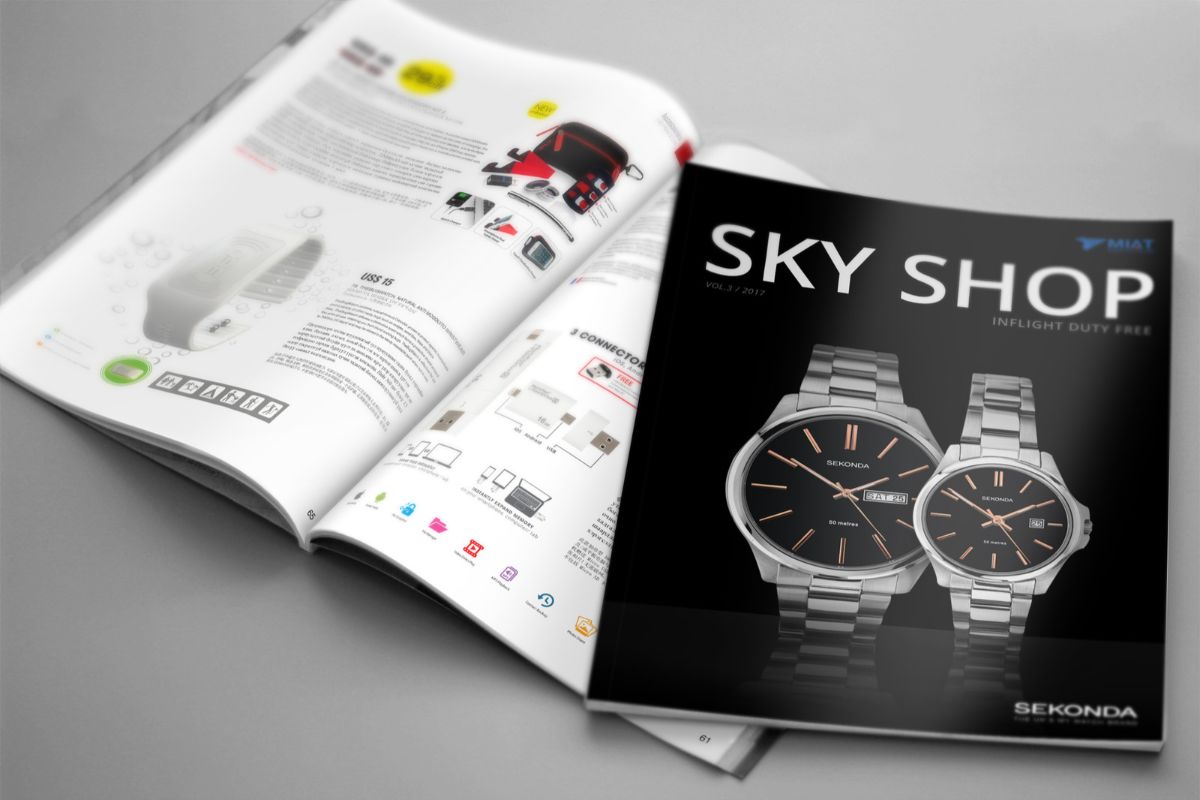
But some brands also make digital magazines to sell their own products and services — not only those of their advertisers. This rather stunning HTML5 magazine from Forbo Flooring is a good example.
The 2017/2018 edition of My Volvo Magazine is another exceptional example of an online magazine that is designed to move product. Rather than creating simple ads, Volvo devoted an entire magazine, full of long-form content and stunning imagery to market a selection of their products to their target audience.
5. How to structure your online magazine
When we discuss structuring a magazine, we focus on the sections to include and their order. This is your editorial formula.
The choice you make here depends on the type of online magazine you want to create. It also depends on your magazine's goal and your target audience. The good news is that a digital magazine gives you more freedom and flexibility than a printed one.
Let's first cover the most common sections that almost always appear in traditional magazines.
5.1 Cover pages
Traditional print magazines have four "cover" pages: the front and back covers and the insides of the covers, usually reserved for the most expensive ads.
However, because we're dealing with digital formats, the "inside" covers are not distinct from any other page. The same goes for the back cover — you can't exactly hold a digital magazine and turn it over, so the back cover isn't necessarily relevant.
So that leaves the front cover. This is the part everyone will see and it plays a big part in whether potential readers choose to open your magazine. You should give a lot of thought as to how you design it and what it should feature.
What should go on your front cover?

A good rule of thumb is that, if you want to stand out among your competition, your cover needs to be striking. Your choice of colors, visuals, and typography should be well chosen and compelling. Besides this, there are a few pretty standard things to include on a magazine cover:
- Your brand logo or title of your magazine
- A featured image or illustration
- The publication date (optional)
- The issue or edition number (optional)
- A subtitle or name of the edition (optional)
- Some highlights about what's inside (Not everyone will visit all your pages, so showing your most important articles on the cover may increase the likelihood they’ll read them)
One of the advantages of a digital magazine (depending on the technology you're using) is that you can use a fullscreen background video for the cover instead of a static image. This is a great way to stand out and attract attention. It's even possible to include a button to encourage people to "keep reading" or "open the magazine."
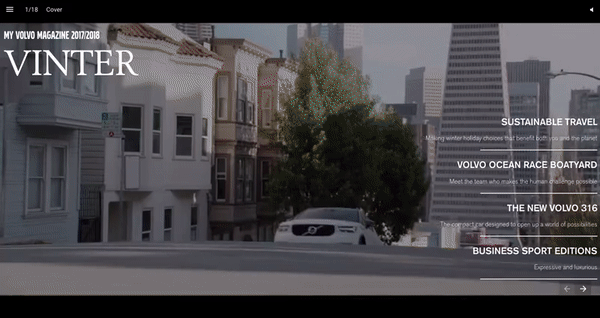
Online magazine with a background video for a cover
5.2 Front of the book
"Front of the book" is magazine terminology for several pages usually in the beginning of the magazine, including the table of contents, impressum, the editor's letter, and comments or letters from readers.
Of course, depending on your goal and target audience, you can choose which of these are relevant for your magazine. Let's quickly go through each of these with a short explanation.
5.2.1 Table of contents
This is almost always the first page of a magazine, although, in digital publishing, some magazines combine this with their cover page. At the very least, it should list all of the featured articles in the magazine, if not everything.
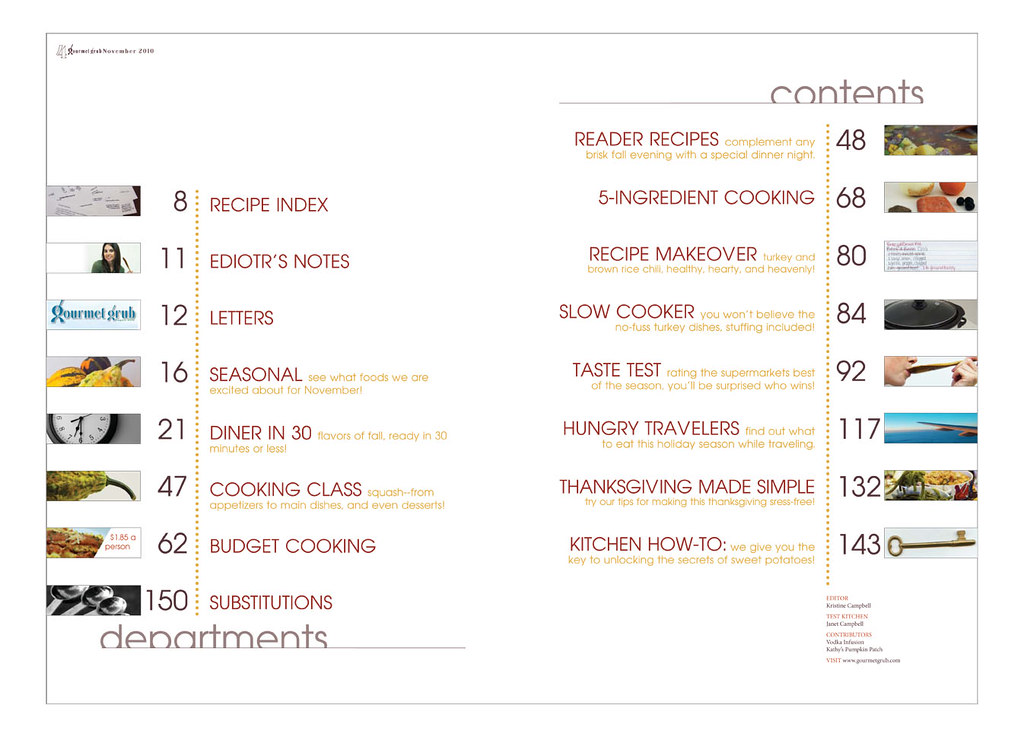
A big advantage of digital magazines is that you can turn the items in your table of contents into hyperlinks so that readers can easily jump to the section that interests them.
5.2.2 The impressum or masthead
The masthead is usually found at the beginning of the magazine, but it can also be at the back. This page lists everyone involved in making the magazine. It includes the editorial stage, marketers, content producers, designers and other important people.
Depending on the type of magazine you're creating, this section may or may not be necessary. If you're creating a magazine that will serve as a product catalog, for example, you might leave it out entirely.
Remember that today's readers have short attention spans, and you want to get them to the important stuff right away. With this in mind, you might consider putting it at the back.
5.2.3 Letter from the editor
Again, this will vary depending on the style of your magazine. Usually, the letter from the editor is a welcoming message that briefly covers the contents of the magazine, gives some important information, or touches on recent news.

A staff magazine often replaces this with a letter from the CEO or head of human resources. In either case, it serves to give your magazine more of a human touch and make it feel less like comes from a faceless brand.
5.2.4 Letters from readers
This section is optional and obviously depends on whether you receive such letters. Magazines with a large reader base may have the luxury of hundreds of letters from which to choose the most interesting. Smaller publications probably don't receive enough reader feedback to create a dedication section, but this also depends on the frequency of your magazine.
If you have the material, however, including letters from readers is a great way to show other readers that they're not the only ones reading. It helps to create a community feeling around your magazine, which can be valuable.
5.3 The feature well
This is the main part of your magazine where your featured articles go. Size-wise, this should be the most substantial section.
It's always good to add variety here. Use a combination of longer and shorter articles. Mix that up with interviews, reviews, opinion pieces — or whatever is relevant to your subject matter. Staff magazines, for example, might feature an interview with an employee of the month and then a short piece about next month's targets.
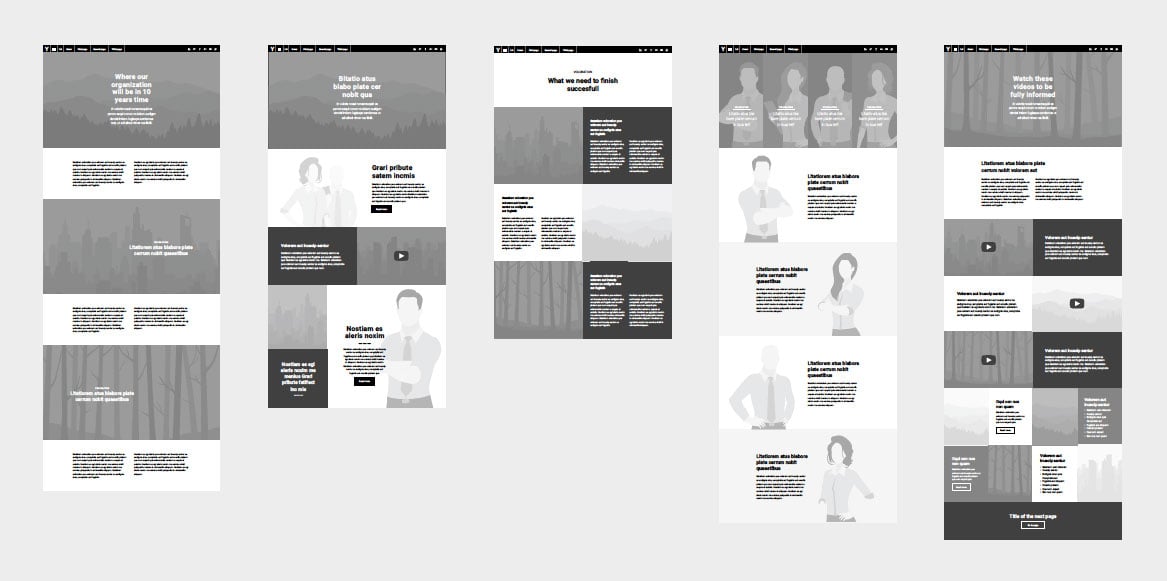
Add variety in the types of featured articles you include
It's important to keep your features visually distinct so that readers know when they've moved from one article to the next. Your layout and color choices should make this distinction clear while also serving to make for a pleasant reading experience.
In a digital magazine you can include more than just text and images. Videos are a great way to add more engaging content. Interactive, animated charts and graphs are popular.
Overlays and popups that readers can open to see more content are also fun to play with. HTML5 magazines even allow you to add forms and collect feedback from your readers right on the page.
5.4 Back of the book
The back of the book is where everything else goes. But that isn't to say it shouldn't be interesting. In many magazines, you'll find classified ads, horoscopes, and smaller columns. But this greatly depends on the type of magazine.
Generally speaking, advertising in this part of the magazine is cheaper than in the front of the book or in the feature, as it tends to get less attention.
Some magazines put the impresario in the back of the book rather than the front. There's even more reason to do this for a digital magazine: you want new readers to get to your best content as quickly as possible.
The last pages can be a great place to add contact forms or even calls-to-action (CTAs) if you're using your magazine for sales or marketing purposes. If you're running a traditional subscription-based magazine, don't forget to provide a way for potential advertisers to get in touch.
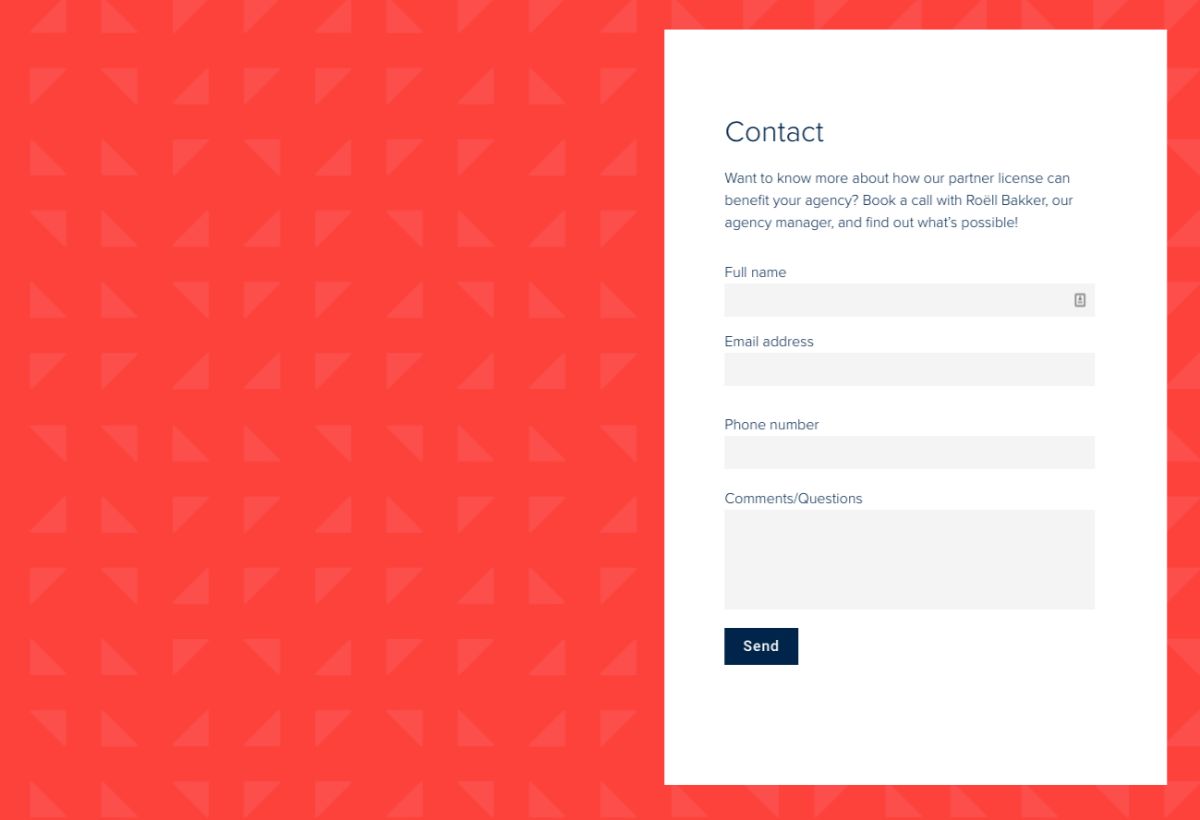
6. Online magazine revenue models
Most people want to earn a good return on investment (ROI) with their magazines, whether directly through selling subscriptions or indirectly, for example by providing customers with relevant, inspiring material that encourages them to stay engaged with their brand.
Before we go further, it's important to mention that much of the publishing industry, in general, has endured difficult times recently as social media and free content has grown in popularity and people spend less time reading traditional magazines.
The good news, however, is that you have a huge advantage with a digital publishing platform for magazines.
This section will discuss various revenue models you can implement for your digital magazine. The model(s) you choose will largely depend on your goal, the style of your magazine, and the technology you choose.
6.1 Subscriptions and single copy sales
The most obvious way that magazines earn money is through sales, either via an intermediary or as a subscription service. Let's look at how traditional print magazines do it and compare that with online magazines.
6.1.2 Single copy sales
If you go to the local newspaper store and purchase a magazine, only a portion of what you pay ends up as profit for the magazine's publisher.
Single-copy sales are usually the least profitable ways for magazines to earn revenue. When you consider the printing and distribution costs, the margin is not very large. On top of that, the magazine typically pays for space on the newsstand's shelves.
Profit = revenue - production costs - printing costs - distribution costs - shelf costs
6.1.3 Subscription sales
Subscriptions are far more profitable because publishers can eliminate one of the middlemen. The publisher ships magazines directly to readers and doesn't have to pay for shelf space. Also, income tends to be more predictable because subscribers typically pay in advance.
Profit = revenue - production costs - printing costs - distribution costs
Still, for a printed magazine that sells subscriptions, the revenue will always be offset by how much it costs to print and ship. Printing and distribution costs are typically the largest expense for any magazine.
The huge advantage of online magazines is that they entirely eliminate printing and shipping costs.
6.1.3 Decreasing marginal costs
Another thing to consider is that, with physical magazines, a unit must be printed and shipped for every copy sold. Thus, your total costs increase as you sell more. You also run the risk of printing too many upfront.
Profit = (sale price x units sold) - (cost per unit x units printed)
On the other hand, a digital magazine only needs to be created once. Because it's virtual and not physical, it can be sold unlimited times without incurring additional costs.
Profit = (sale price x units sold) - 1-time production cost
With a digital magazine, your cost per unit is simply your 1-time cost divided by the number of sales (i.e., it shrinks as you sell more).
6.1.4 Selling digital magazine subscriptions
While eliminating printing and shipping costs makes creating and selling digital online magazines much cheaper and accessible for more people, there will be other costs involved.
For example, if you decide to sell subscriptions via Zinio or Kindle, you will pay a membership fee and most likely a percentage of all your sales. This is comparable to the shelf fee a print publication pays to newsstands. These magazine services provide various options for you to promote your magazine to existing users of the platform.
Similarly, if you create native apps for your magazines, both Apple and Google retain approximately 30% of the revenue you generate from selling your app or providing in-app purchases, in addition to the initial registration fee. Your ability to sell subscriptions will depend on your app's performance in the app store.
With an HTML5 magazine, you have more control over your digital marketing without having to rely on Apple's, Google's, or Zinio's existing audiences. You will pay for using most HTML5 magazine software platforms to create content, but they don't typically take a cut of your sales. Your magazines will exist on any URL you choose, making it easy to share on social posts or promote through email marketing.
6.2 Selling ads
The other most common way for magazines to earn revenue is through advertising. It's extremely rare to find a magazine that doesn't contain ads. Most magazines use a combination of subscriptions and advertising to generate multiple streams of revenue.
6.2.1 Classified ads
Just like in a newspaper or printed magazine, digital magazines can contain classified ads where just about anyone can pay for space. Classified ads are typically small, include just a few lines of text, maybe an image, and some contact information. They usually appear in the back of the book.
What makes classified ads more interesting in digital format is that they can contain hyperlinks with UTMs that the advertiser can use to track the source of the traffic they generate. This gives advertisers a far better understanding of the performance of their ads than they would obtain from a printed version.
Your ability to generate revenue from classified ads depends on the circulation and popularity of your magazine. The more people read your magazine, the more advertisers will be willing to pay for space.
6.2.2 Display ads
Display ads are the most common and easily recognizable ads in a magazine. They are often distributed throughout an entire publication and clearly display some product or service. Display ads are far more expensive than classified ads (often costing thousands of dollars) because of their location in the magazine and the amount of space allowing for a great deal of exclusivity.

Again, a brand's willingness to pay for advertising space will depend on the reach of your magazine. If you're just starting out it will be difficult to attract advertisers. But as your readership grows, this can become a major income source.
A benefit of digital magazines is that you can include dynamic display ads — the most common being Google Adwords. With these kinds of ads, you provide the space for the ad, but Google determines what content will show up in that space based on the reader's previous browsing behavior. One advantage here is that you don't need to negotiate with individual advertisers; Google pays you for the number of times your ad is clicked.
6.2.3 Advertorials and sponsored content
Advertorials (sometimes referred to as native ads) are a form of advertisement that usually takes the form of a story. Reader's may often confuse them with editorial content. However, most publications include a note that the article is "sponsored content" paid for by an advertiser, or simply add a label that marks the article as an advertorial.

Native ads are less disruptive to the reading experience than display ads. They are not intended to fool readers into thinking they are editorial pieces — readers can readily tell when they're reading sponsored content — but they make ads more interesting and relevant as they fit the flow and design of the magazine.
Rather than focusing directly on selling a product or service, native ads tell an interesting story, or highlight some fun facts that are both relevant to the publication they're in and the company that sponsors the piece.
How much should you charge for native ads? That can be a tough question. HubSpot offers ideas on pricing for sponsored content. However, you should also think about a few factors. First, consider if the content is helpful for your readers. next, ask if it improves your magazine's overall experience. Finally, think about whether you want a long-term partnership with the advertiser.
Oh, and if you intend to attract advertisers, don't forget to include contact information in your magazine for them to get in touch!
6.3 Content paywalls
Today's content consumers are used to getting things for free. Many magazines and newspapers now use "freemium" models where they offer a number of articles free of charge, but pay for access to additional content.
The New York Times, for example, allows you to read 3 articles per month before requiring you to subscribe. Other magazines don't limit the number of articles, but place their "high quality" pieces behind a payment wall.
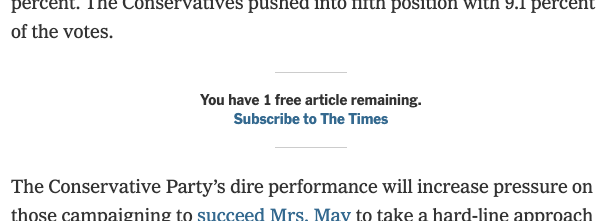
Still other magazines allow you to read the first several pages before you run into a screen which requires you to sign up.
Offering content for free is a great way to get more exposure and generate more brand awareness around your magazine, especially in the beginning. People like to "try before they buy," and offering a taste of what they'll get increases their confidence when deciding to purchase a subscription.
Your ability to generate revenue with this model depends on the quality of your magazine's content. Is it engaging and interesting enough for people to want to pay to get more?
HTML5 magazines like those created with Foleon, allow you to gate your magazine at any point throughout the publication, requiring readers to log in or sign up before continuing.
6.4 Generating leads
As we discussed in Chapter 4, magazines can have different goals. Not everyone who produces a magazine is a publisher. Many organizations create magazines for marketing purposes to engage their audience rather than to generate revenue directly.
Still, for these types of magazines to be worthwhile, some kind of return should be expected, whether it's increased engagement with your brand (as Airbnb magazine does) or more ideas for shopping (as Wholefoods magazine does), or something else.
One of the most popular ways to use digital magazine as a marketing asset is to collect reader information and generate leads. Online marketers often create "content offers" such as eBooks, white papers, and guides that site visitors can download after filling in their personal information.
In most cases, the sales or marketing department will use the gathered information to follow up with visitors, offering them some kind of promotion and nudging them towards becoming a customer.
Online HTML5 magazines are a great format for lead-generating content offers that help to fill your sales funnel. In a world where most marketers still put their eBooks and whitepapers in PDF format, responsive, interactive digital magazines can be a big differentiator.
7. Choosing the right online magazine template
In a market where the volume of digital marketing published content increases rapidly every day, visual presentation has never been more important to maintain your audience's attention.
For online magazines, the template you choose to showcase your content can make or break the success of your publication. The template you choose is more than just an aesthetic choice. It's a strategic decision that impacts user experience, engagement, and even the perception of your brand.
Here are some considerations you should take into account when selecting your online magazine template.
7.1 Target audience and content
The two biggest influences that will determine the selection of your online magazine template are your target audience and the types of content you are publishing.
For example, if you are creating a catalog that explores trends in interior design or popular travel hot spots you'll want to choose a template with visually appealing galleries perfect for high-resolution imagery or videos. Text-oriented templates are better suited for research-heavy interactive white papers or annual reports. Think about your target audience's preferences and how the template can improve the engagement of your content.
7.2 Design flexibility with drag and drop interface
To get the most out of your online magazine make sure that the content creation platform you are using features professionally designed magazine templates that are easy to use and completely customizable. This will allow everyone in your team to create content quickly without requiring coding experience.
Customizable templates give you a starting foundation to build your online magazine any way you like by easily changing colors, fonts and layouts with the ability to add or remove sections according to your brand guidelines.
7.3 Mobile experience and device responsiveness
With over 55% of website traffic coming from people using mobile devices, it is essential that your online magazine is fully responsive. Most content creation platforms have built-in software that will automatically resize your content to various screens but it is always worth testing across several devices before publishing any new magazine content.
Furthermore, website speed is one of the most important factors in user experience and can dramatically affect organic rankings. According to seciton.io 32.3% of visitors bounce when the page load exceeds 7 seconds. Taking website performance into account when building your online magazine is a critical factor in expanding your readership.
8. 5 Inspiring examples of online magazines
Before you dive into creating your online magazine, why not get some inspiration? Check out these fantastic examples of online magazines created by Foleon customers to see how they’re implementing best practices.
Nestlé's Cuisine Magazine
As the world’s leading food and beverage company, Nestlé created the IAMCHEF magazine to highlight the work of talented chefs around the world. This edition focuses on award-winning Dutch chef Bjorn Massop and showcases his culinary work with beautiful photography, embedded video, and interviews with the chef himself. The magazine perfectly balances text, imagery, and interactivity to keep people reading.
Vitality Winer Magazine
Vitality is a leading insurance company with over 2000 employees worldwide. In the traditional world of insurance providers, they’re aiming to stand out from the crowd and showcase their unique brand and approach. Their interactive magazine for members and prospects provides Vitality with a platform to do just that. And with Foleon, they were able to go beyond the limitations of print by incorporating video, audio, and interactive elements into their magazine while keeping the look and feel in line with their brand.

-
Hoare Lea Lifestyle Magazine
Engineering consultancy Hoare Lea created their thought leadership magazine, Exploare, as a platform for sharing articles on topics relevant to their target audience, like recent innovations in tech, economics, climate change, and space design. This interactive format allowed them to break up articles into easy-to-digest sections and use data visualizations and photography for better readability and understanding. 
-
LCP
Consultancy firm Lane Clark & Peacock provides their clients with market-leading advice regarding pensions, investment, and insurance. Their online magazine, Vista, gives new or soon-to-be investors insights into recent developments in the markets and the world of finance, so they can make more informed decisions. By combining rich media like video and audio with photography, text, and data visualizations, LCP gave readers a truly interactive experience and made even complex concepts approachable and easy to grasp.
-
Aida Cruises
AIDA Cruises has one of the world's most modern and varied cruise fleets. Their AIDA Inspiration magazine aims to motivate travelers to think outside the box and discover new cruise destinations for their vacations. This particular edition focuses on their cruise to the Nordic countries, and uses sleek design, beautiful photography and clever animations to get readers inspired and keep them engaged.
-
9. ConclusionNo matter which route you take, creating an online magazine from scratch is a big job. From creating and curating content to working with advertisers and media partners, there is a lot to consider. Hopefully, this article provides you with enough information to start making important decisions like what platform you'll use and how you'll finance your magazine.
A final piece of advice we'll leave you with is that content is king. In the end, the success of your magazine will depend mostly on how good your content is. If you create great content that engages and inspires, readers will return got more. You will reach your goals, where you want to charm readers, educate employees, sell products or make a profit.
